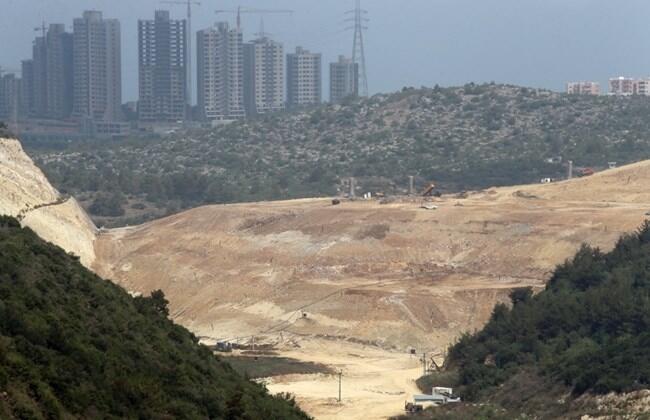But residents are not reacting to the supernatural; they are sensitive to the stench that emerges from the great Naamehlandfill, which sits toward the sea. And Friday, they plan to stage a sit-in at its gates, to force it to close and rescue their air. “Either we’re going to force them to leave, or they’re going to force us. There’s no other alternative,” said Tarek Salem Gharzeddine, the mukhtar of nearby Baourta. “This is a displacement, like in 1982,” he said, comparing the interminable fill operation to the Israeli invasion that crumbled the village. A sit-in last year caused trash to pile up in Beirut’s streets. Disaffected Chouf residents Wednesday won the support of Progressive Socialist Party leader Walid Jumblatt’s parliamentary bloc, the Democratic Gathering, which includes several Chouf MPs. “July 17 is the final deadline to close Naameh landfill, and we will not accept any extension,” the bloc said in a statement. Cabinet has twice delayed closing the site in the past 18 months. The Lebanese government Friday informed the Council of Development and Reconstruction that the notorious landfill would continue to be operational beyond Friday. “The government has not shown any commitment to relieving the health and environmental harm borne by the people of this region,” the Democratic Gathering said. Gharzeddine, like all the residents The Daily Star spoke with in the Naameh area, believes the Naameh landfill is causing cancer. His sister died in 2008 at the age of 40 from a rare form of it, he said. In Ain Drafil, which is even closer to the site than Baourta, the church deacon Yousef Maroun Farah described the landfill as “death and more death.” No peer-reviewed studies have been published about the health hazard, but Dr. Amin al Kazzi, a physician at the nearby DamourMedical Center, conducted his own examination and found that incidences of blood cancer among residents of the area is four times greater than the baseline. Kazzi compared the diagnoses of people who returned to the Damour area after the Civil War with those who did not, according to Ajwad Ayache, an activist with Close Naameh Landfill. The landfill opened in 1997; those who left Damour and did not return could not have been exposed. Kazzi, who also established the Department of Emergency Medicine at the American University Hospital, would not comment to The Daily Star, citing a general proscription from the Order of Physicians against speaking to the media. The Naameh landfill opened in this green valley as a temporary solution to an emergency trash crisis and was supposed to close within six years. But successive governments kept postponing the date, and what began as a brown mound rose to the height of the surrounding bluffs. Gharzeddine estimates the altitude of its peak at over 200 meters. “It was a valley, and now it’s a mountain that reaches the shoulders of Ain Drafil,” he said. The area of the landfill is at least 331 dunams, according to a Daily Star satellite imagery analysis. It plugs a combe that is still magnificent – development is tidy and trees of fig, grape, olive, apple and pine wash over the landscape. But the river that once flowed through is now buried underground, and the western breeze is fatal. “We’d go down there to fish,” said Afif Khaddaj, 58, from Abay. Others said they used to hunt, hike, and chop wood for winter. “No one dares to move back [to Ain Drafil], because of the landfill. We don’t come out of our home until the smell fades in the evening,” Farah said. Little trust remains between the Lebanese government and the residents of this Chouf furrow. When the Naameh landfill opened in the sunset of the 20th century, it was slated to receive 2 million tons of waste. It has instead taken over 15 million tons and receives over 3,000 more each day. Environment Minister Mohammad Machnouk Monday announced the Beirut and Mount Lebanon area would continue to send 600 tons of waste daily to the dump for six more months, despite previous government promises to retire the site by July 17. People in Naameh and surrounding villages say they will not accept another delay, having already agreed twice in the past 18 months to wait. “The environment minister is like the rest of them – he is a liar. I don’t trust this government. If they throw even 1 kilo, we don’t want it,” Gharzeddine said. “We won’t give them another day or even an hour.” Demonstrators last year barred Sukleen trucks from dumping waste in the overfilled site for a week. The waste management company was forced to suspend collection, and garbage fouled Beirut’s streets. This time, residents vow not to leave until the government concedes. “If they are going to drive trucks in after Friday, it’ll be over our bodies,” Baourta resident Ayache said. The Environment Ministry is making an eleventh-hour effort to meet a July 17 deadline to overhaul how Lebanon handles its waste. A government decree tasked the ministry with decentralizing management and tripling the amount of garbage Lebanon recycles, composts and incinerates. Machnouk described the coming six months as a “period of transition,” as government agencies sign contracts and companies begin their services. The minister expressed gratitude Monday to residents around the Naameh landfill for “being patient and bearing this burden for 18 years.” The Daily Star











